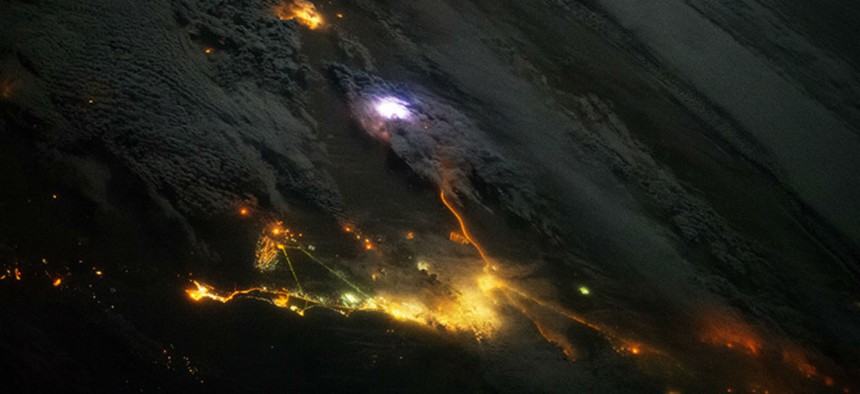NASA Engineer Explains Why Trump’s Plan to Cut the Space Agency’s Climate Science Program Is Harder than It Sounds

NASA
Cutting the programs could be a logistical nightmare.
Within weeks of the U.S. election, President Donald Trump said he intended to scrap NASA’s research on climate change, shifting those resources—less than $2 billion of the agency’s $19 billion budget—to its space program.
Other Republicans have echoed that goal. Oklahoma state Sen. Jim Bridenstine, who is reportedly being considered (among others) to run NASA, once called on Barack Obama to apologize to the people of Oklahoma for funding climate change research. Texas Rep. Lamar Smith, chairman of the House committee on Science, Space and Technology, said earlier this month NASA should be focused on space, not climate change, because “another dozen agencies” are already studying the latter.
But cutting NASA’s climate science research could prove to be an expensive, logistical nightmare, according to a contractor who works as an engineer for one NASA satellite that collects climate data. The engineer requested to remain anonymous to avoid jeopardizing their employment at the agency.
NASA currently has 16 Earth science satellites in orbit (and three other Earth science instruments attached to the International Space Station) that, in addition to climate data, collect information on the atmosphere, oceans and land-based phenomena like wildfires. The satellites make up the core of NASA’s climate science program, and the most immediate problem with eliminating climate research is what would become of them.
“If you stopped operations—if nobody manned the satellites—they would crash and spread space debris,” the engineer said. NASA currently tracks around 500,000 pieces of space debris traveling at extremely high speeds; satellite engineers must steer their spacecraft to avoid them.
If a satellite crashes into a piece of debris, the satellite would splinter, possibly sending “40,000 or 50,0000 pieces of space debris into low Earth orbit,” the engineer said. “Then you have to try to account for all those pieces of debris. That would be truly a crisis. They wouldn’t de-staff our teams just because of that danger.”
Transferring satellite operations to a different agency would be costly. NASA’s Earth science satellites are operated in large part by contractors, many with five-year agreements, who use specialized equipment at NASA’s Goddard Space Flight Center in Maryland. Severing those agreements, and physically moving those machines to a different agency’s headquarters, would be a massive headache.
“All the engineers and scientists are geographically living near the center where we work,” the engineer said. “All the resources—all that stuff is geographically tied down.”
Even if the Trump administration wanted to remove those satellites from space entirely, the logistics and red tape surrounding the “deorbiting process”—delicately bringing a satellite back to Earth—can take “years and years,” said the engineer, who worries more about the administration leaving the satellites in place and simply ceasing data collection.
Budgetary waste is a common refrain among those seeking to end climate science at NASA. Because other U.S. agencies like the Environmental Protection Agency and the National Oceanographic and Atmospheric Administration also study climate change and Earth science, critics argue, there is a degree of redundancy in NASA’s work.
But redundancy isn’t wasteful; it is a basic tenet of high-quality science. If more than one set of data point to the same trend or conclusion (especially if they were collected by entirely separate scientists at separate agencies), scientists can have more confidence the conclusion is correct.
For that very reason, climate scientists often use climate data gathered by NASA, NOAA and EPA. Eliminating any of these data sources would reduce the overall diversity of data and, by default, the scientific rigor of U.S. research. It would also consolidate data collection into the hands of fewer political appointees.
Already, grassroots efforts are underway at universities around the country to download and store federal science data. “Data rescue” groups have managed to harvest NASA’s Earth science data, as well as much of NOAA’s and EPA’s data. NASA employees have taken notice.
“We’re all pretty excited by it,” the engineer said. The data rescue initiatives have gained urgency in the wake of Scott Pruitt’s confirmation as EPA administrator, as NASA employees worry he could pull EPA’s climate data from public view.
“Censorship is my No. 1 concern,” the NASA engineer said. “Once you consolidate the sources of data, it’s easier to censor.”





